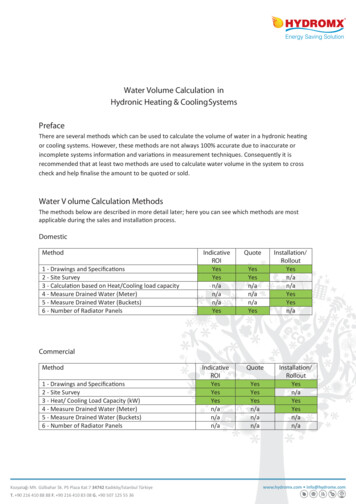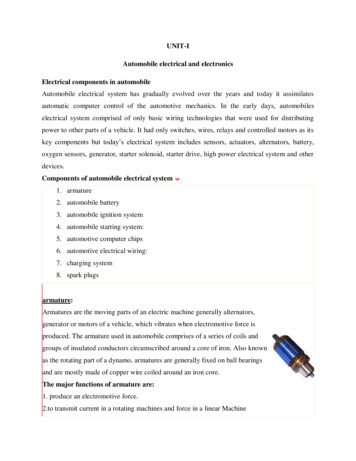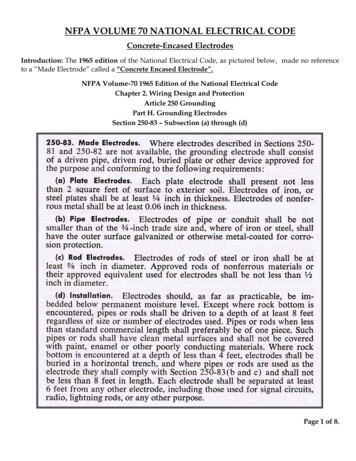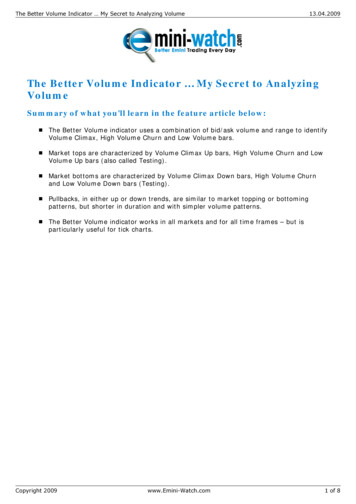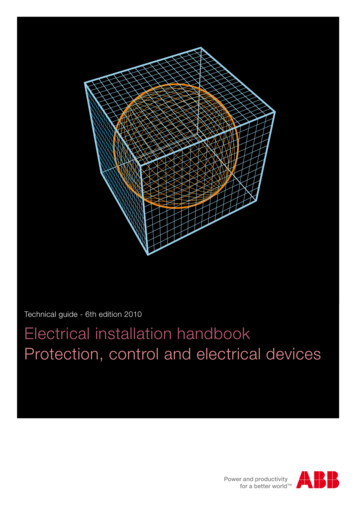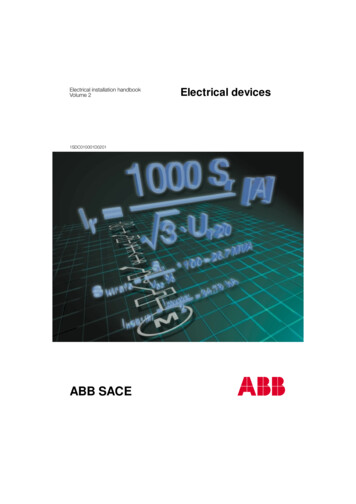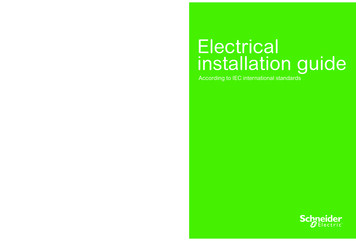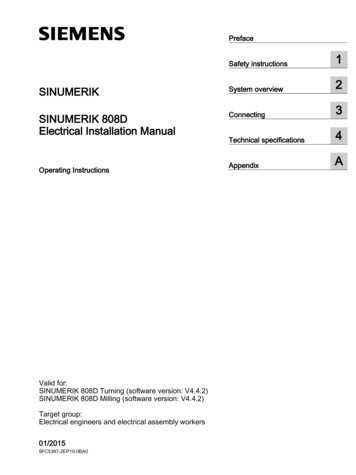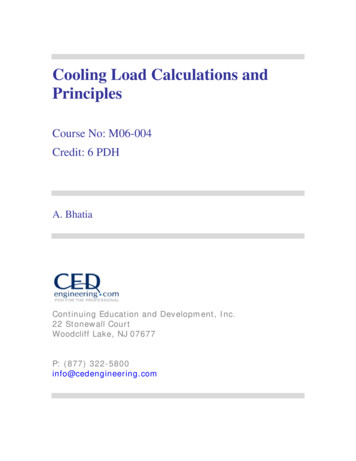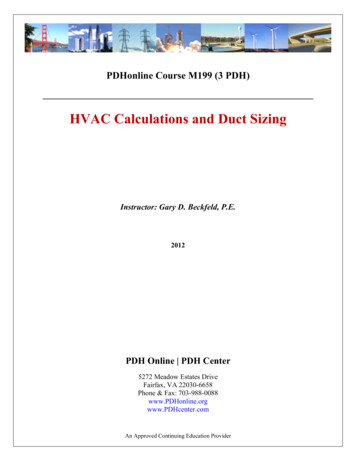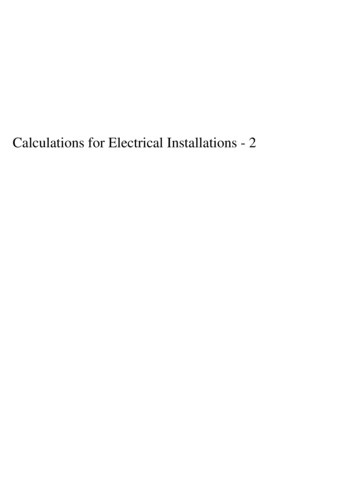
Transcription
Calculations for Electrical Installations - 2
ContentsPrefaceviiUse of calculators1Simple transposition of formulae3SI units5Conductor colour identification7Alternating current circuit calculations8Impedance8Inductive reactance11Capacitive reactance14Impedance in series circuits17Impedance triangles and power triangles27a.c. waveform and phasor representation39Alternating e.m.f. and current39Phasors45Parallel circuits involving resistance,54inductance and capacitancePower factor improvement62Calculation without p.f. correction64Calculation with p.f. correction65Three-phase circuit calculations69Star-connected motors69Delta-connected motors (mesh)71Resistance and inductance in three-phase circuits73Three-phase circuits78Three-phase power81Voltage drop in three-phase circuits86v
Voltmeters and ammeters: changing the use and104extending the rangeVoltmeters104Ammeters106Alternating current motors110Application of diversity factors117Cable selection124Earthing conductor calculation124Voltage drop and cable selection calculations129Earth leakage protection calculations143Lighting calculations149Units and quantities149Inverse square law150Cosine law151Mechanics156Moment of force156Torque156Power157Surface speed, pulley diameter and speed ratios159Miscellaneous examples165d.c. generators165d.c. motors166Alternators and synchronous motors167Induction motors168Insulation resistance168Formulae173Glossary178Answers182vi
PrefaceMathematics forms the essential foundation of electricalinstallation work. Without applying mathematical functionswe would be unable to work out the size of a room which needslighting or heating, the size and/or the number of the lights orheaters themselves, the number and/or the strength of the fixingsrequired, or the size of the cables supplying them. We would beunable to accurately establish the rating of the fuse or circuitbreaker needed to protect the circuits, or predict the necessarytest results when testing the installation. Like it or not you willneed to be able to carry out mathematics if you want to be anefficient and skilled electrician.This book will show you how to perform the maths you willneed to be a proficient electrician. It concentrates on theelectronic calculator methods you would use in class and in theworkplace. The book does not require you to have a deepunderstanding of how the mathematical calculations areperformed; you are taken through each topic step by step, thenyou are given the opportunity yourself to carry out exercises at theend of each chapter. Throughout the book useful references aremade to Amendment 2:2004 BS 7671 Requirements for ElectricalRegulations and the IEE On-Site Guide.Volume 2 Electrical Installation Calculations originally written byA. J. Watkins and R. K. Parton has been the preferred book formany students looking to improve their mathematicalunderstanding of the subject for many years. This edition hasbeen newly updated not only to include modern methods,but also to cover all aspects of the new City and Guilds 2330Certificate in Electrotechnical Technology.This second volume includes advanced calculations, inparticular those involving cable selection. As well as beingvii
invaluable to students studying for the City and Guilds 2330, it willalso be of considerable use to those involved in electricalinstallation work, particularly if studying for the City andGuilds 2391 Inspection and Testing, 2400 Design andVerification and the 2381 exams.viii
Use of calculatorsThroughout Books 1 and 2, the use of a calculator is encouraged.Your calculator is a tool, and like any tool practice is required toperfect its use. A scientific calculator will be required, andalthough they differ in the way the functions are carried out,the end result is the same.The examples are given using a Casio fx-83MS. The figuresprinted on the button is the function performed when the buttonis pressed. To use the function in small letters above any buttonthe shift button must be used.PRACTICE IS IMPORTANTSyntax errorx2x3 3Appears when the figures are entered in the wrongorder.Multiplies a number by itself, i.e. 6 6 36. Onthe calculator this would be 6x2 36. When anumber is multiplied by itself it is said to be squared.Multiplies a number by itself and then the totalby itself again, i.e. when we enter 4 on calculatorx3 64. When a number is multiplied in this wayit is said to be cubed.Gives the number which achieves the total by being multiplied by itself, i.e. 36 6. This is said to bethe square root of a number and is the opposite ofsquared.Gives you the number which when multiplied by itself three times will be the total. 3 64 4 this issaid to be the cube root.1
x 1EXPBracketsDivides 1 by a number, i.e. 14 0.25 This is thereciprocal button and is useful in this book for findingthe resistance of resistors in parallel and capacitors inseries.The powers of 10 function, i.e.25 1000 25 EXP 103 25 000Enter into calculator 25 EXP 3 25 000. (Do notenter the or the number 10.)If a calculation shows 10 3 , i.e. 25 10 3 enter25 EXP 3 (0.025) (when using EXP if a minusis required use the button ( ))These should be used to carry out a calculation withina calculation. Example calculation:32 65.46(0.8 0.65 0.94)Enter into calculator 32 (0.8 0.65 0.94) Remember, Practice makes perfect!2
Simple transposition offormulaeTo find an unknown value: The subject must be on the top line and must be on its own. The answer will always be on the top line. To get the subject on its own, values must be moved. Any value that moves across the sign must movefrom above the line to below line orfrom below the line to above the line.EXAMPLE 13 4 2 63 4 2 ?Transpose to find ?3 4 62EXAMPLE 22 6 4?Step 12 6 4 ?2 6 ?42 6Answer 34Step 23
EXAMPLE 35 8 6 3 20 ?Step 1: move 3 20 away from the unknown value, as the knownvalues move across the sign they must move to the bottom ofthe equation5 8 4 ?3 20Step 2: Carry out the calculation5 8 6240 43 2060Therefore5 8 6 2403 20 4 240or5 8 6 3 20 4.4
SI unitsIn Europe and the UK, the units for measuring differentproperties are known as SI units.SI stands for Système Internationale.All units are derived from seven base units.Base quantityBase unitSymbolTimeElectrical currentLengthMassTemperatureLuminous intensityAmount of esAmkgKcdmolSI-DERIVED UNITSDerived quantityNameSymbolFrequencyForceEnergy, work, quantityof heatElectric charge, quantityof electricityPowerPotential difference,electromotive forceCapacitanceElectrical resistanceMagnetic fluxMagnetic flux densityHertzNewtonJouleHzNJCoulombCWattVoltWV or UFaradOhmWeberTeslaF WbT(Continued)5
Derived quantityNameSymbolInductanceLuminous fluxAreaVolumeVelocity, speedMass densityLuminanceHenryLumenSquare metreCubic metreMetre per secondKilogram per cubic metreCandela per square metreHcdm2m3m/skg/m3cd/m2SI UNIT PREFIXESNameMultiplierPrefixPower of 10TeraGigaMegaKiloUnitMilliMicroNanoPico1000 000 000 0001000 000 0001000 000100010.0010.000 0010.000 000 0010.000 000 000 001TGMk1 10121 1091 1061 103mmhr1 10 31 10 61 10 91 10 12EXAMPLEmAMilliamp one thousandth of an amperekmKilometre one thousand metresmvMicrovolt one millionth of a voltGWGigawatt one thousand million wattskWKilowatt one thousand wattsCalculator example1 kilometre is 1 metre 103Enter into calculator 1 EXP 3 (1000) metres1000 metres is 1 kilometre 10 3Enter into calculator 1000 EXP 3 (1) kilometre1 microvolt is 1 volt 10 6Enter into calculator 1 EXP 6 (1 06 or 0.000 001) volts(note sixth decimal place).6
Conductor colouridentificationPhase 1 of a.c.Phase 2 of a.c.Phase 3 of a.c.Neutral of a.c.Old colourRedYellowBlueBlackNew colourBrownBlackGreyBlueMarkingL1L2L3NNote: great care must be taken when working on installationscontaining old and new colours.7
Alternating current circuitcalculationsIMPEDANCEIn d.c. circuits, the current is limited by resistance. In a.c. circuits,the current is limited by impedance (Z). Resistance and impedanceare measured in ohms.For this calculation, Ohm’s law is used and Z is substituted for R.U I or voltage (U ) impedance (ohms)Z current (amperes)IVZVolt dropFig. 1EXAMPLE 1The voltage applied to a circuit with an impedanceof 6 is 200 volts. Calculate the current in the circuit.U IZ200 33.33 A68
EXAMPLE 2The current in a 230 V single phase motor is 7.6 A.Calculate the impedance of the circuit.U ZI230 30.26 7.6A discharge lamp has an impedance of 265 andthe current drawn by the lamp is 0.4 A. Calculate the voltage.EXAMPLE 3Z I U265 0.4 110 voltsEXAMPLE 4The current through an impedance of 32 is 8 A.Calculate the voltage drop across the impedance.U I Z 8 32 256 VEXAMPLE 5The current through an electric motor is 6.8 A at230 V. Calculate the impedance of the motor.U I ZUI230 6.8 33.82 (Transpose for Z) Z An a.c. coil has an impedance of 430 . Calculatethe voltage if the coil draws a current of 0.93 A.EXAMPLE 6U I Z(Transpose for U ) U I Z 0.93 430 400 V9
EXERCISE 11. Complete the following table:Volts (a.c.)230 400 100 25230Current (A)0.1 15 0.50.01180 25Impedance ( ) 100 1510000.05252. Complete the following table:Current (A)1.92 3.84 18.27.35 4.088.97Volts (a.c.)7.5230 107400 235Impedance ( ) 2.4512.4 96.356 963. Complete the following table:4.5.6.7.Impedance ( ) 232 8500.1251050 129Volts (a.c.)230 400 26.5 0.194238 245Current (A)0.760.5750.0065 0.4360.056A mercury vapour lamp takes 2.34 A when the mainsvoltage is 237 V. Calculate the impedance of the lampcircuit.An inductor has an impedance of 365 . How muchcurrent will flow when it is connected to a 400 V a.c. supply?A coil of wire passes a current of 55 A when connected to a120 V d.c. supply but only 24.5 A when connected to a 110 Va.c. supply. Calculate (a) the resistance of the coil, (b) itsimpedance.Tests to measure the impedance of an earth fault loop weremade in accordance with BS 7671 and the results for fivedifferent installations are given below. For each case,calculate the value of the loop impedance.(a)(b)(c)(d)(e)Test voltage, a.c. (V)9.2512.67.6514.28.72Current (A)19.63.2923.81.0921.18. The choke in a certain fluorescent-luminaire fitting causes avoltage drop of 150 V when the current through it is 1.78 A.Calculate the impedance of the choke.10
9. Complete the following table:Volts (a.c.)Current (A)Impedance ( )61.12.31534.225251937.359.225Plot a graph showing the relationship between current andvoltage. From the graph, state the value of the currentwhen the voltage is 240 V.10. The alternating voltage applied to a circuit is 230 V and thecurrent flowing is 0.125 A. The impedance of the circuit is(a) 5.4 (b) 1840 (c) 3.5 (d) 184 11. An alternating current of 2.4 A flowing in a circuit ofimpedance 0.18 produces a voltage drop of(a) 0.075 V(b) 13.3 V(c) 0.432 V(d) 4.32 V12. When an alternating e.m.f. of 150 V is applied to a circuit ofimpedance 265 , the current is(a) 39 750 A(b) 1.77 A(c) 5.66 A(d) 0.566 AINDUCTIVE REACTANCEWhen an a.c. current is passed through a conductor, a magneticfield is created around the conductor. If the conductor is woundinto a coil the magnetic field is increased. Where there aresignificant magnetic fields in a circuit there is opposition to theflow of current, this opposition is called inductive reactance.The opposition caused by inductive reactance is in addition to theopposition caused by the resistance caused by the wires.In this section, we will assume that the resistance of the circuitsis so low that it may be ignored and that the only opposition to theflow of current is that caused by the inductive reactance.The formulae for inductive reactanceis XL 2pfL (answer in ohms).Where L is the inductance of the circuit or coil of wire and isstated in henrys (H), f is the frequency of the supply in hertz (Hz).11
HIFig. 2EXAMPLE 1Calculate the inductive reactance of a coil whichhas an inductance of 0.03 henrys when connected to a 50 Hzsupply.XL 2pfL 2 3.142 50 0.03 9.42 EXAMPLE 2Calculate the inductive reactance of the coil inexample 1 when connected to a 60 Hz supply.XL 2pfL 2 3.142 60 0.03 11.31 It can be seen from this calculation that if the frequency increasesthe inductive reactance will also increase.An inductor is required to cause a voltage drop of180 volts when a current of 1.5 A is passed through it at afrequency of 50 Hz.EXAMPLE 3Calculate the value of the inductor:UL I XL (this is Ohm’s law with inductivereactance instead of resistance)12
TransposedU XLI180 120 1.5XL 2pfL120 2 3.142 50 LTranspose120 0.381 H(2 3.142 50)On calculator enter 120 (2p 50) (answer 0.382 H)EXERCISE 21. Calculate the inductive reactance of a coil having aninductance of 0.015 H when a 50 Hz current flows in it.2. A coil is required to have an inductive reactance of 150 on a 50 Hz supply. Determine its inductance.3. Complete the following table:Inductance (H)Frequency (Hz)Reactance ( )0.04500.125050360.0084.560574. A coil of negligible resistance causes a voltage drop of 98 Vwhen the current through it is 2.4 A at 50 Hz. Calculate(a) the reactance of the coil, (b) its inductance.5. A reactor allows a current of 15 A to flow from a 230 V50 Hz supply. Determine the current which will flow at thesame voltage if the frequency changes to (a) 45 Hz,(b) 55 Hz. Ignore the resistance.6. Calculate the inductive reactance of coils having thefollowing values of inductance when the supply frequencyis 50 Hz.(a) 0.012 H(d) 350 mH(b) 0.007 H(e) 0.045 H(c) 0.45 mH13
7. Determine the inductances of the coils which will have thefollowing reactance to a 50 Hz supply:(a) 300 (d) 125 (b) 25 (e) 5 (c) 14.5 8. The inductance of a coil can be varied from 0.15 H to0.06 H. Plot a graph to show how the inductive reactancevaries with changes in inductance. Assume a constantfrequency of 50 Hz.9. A reactor has a constant inductance of 0.5 H and it isconnected to a supply of constant voltage 100 V but whosefrequency varies from 25 to 50 Hz. Plot a graph to showhow the current through the coil changes according to thefrequency. Ignore the resistance of the coil.10. Calculate the voltage drop across a 0.24 H inductor ofnegligible resistance when it carries 5.5 A at 48 Hz.11. An inductor of 0.125 H is connected to an a.c. supply at50 Hz. Its inductive reactance is(a) 39.3 (b) 0.79 (c) 0.025 (d) 393 12. The value in henrys of an inductor which has an inductivereactance of 500 when connected in an a.c. circuit atfrequency 450 Hz is(a) 1.77 H(c) 0.177 H(b) 14 106 H(d) 0.071 10 6 HCAPACITIVE REACTANCEWhen a capacitor is connected to an a.c. supply, the current flow islimited by the reactance of the capacitor (XC ).Formula for capacitive reactance XC 1062pfCwhere C is the capacitance of the capacitor measured inmicrofarads (mF) and f is the frequency of the supply in hertz (Hz).(It should be noted that d.c. current will not flow with a capacitorin the circuit it will simply charge and then stop.)14
CIHzFig. 3Calculate the reactance of a 70 mF capacitor to aEXAMPLE 150 Hz supply:XC 1062pfC106 45.47 2 3.142 50 70Enter on calculator EXP 6 (2p 50 70) (answer 45.47).A power factor improvement capacitor is requiredto take a current of 7.5 A from a 230 volt 50 Hz supply.Determine the value of the capacitor.For this calculation, Ohm’s law is used and R is substitutedby XC .Step 1EXAMPLE 2UC I X C230 7.5 XCTranspose for XC230 XC7.5230 30.6 7.515
Step 2 to find CXC 1062pfCTranspose C C 1062p f XC106(2 3.142 50 30.6) 104 answer in microfarads (mF)(Note simply change places of XC and C)Enter on calculator EXP 6 (2p 50 30.6) orEXP 6 (2 3.142 50 30.6)EXERCISE 31. Determine the reactance of each of the following capacitorsto a 50 Hz supply. (Values are all in microfarads.)(a) 60(d) 150(g) 250( j) 75(b) 25(e) 8(h) 95(c) 40(f) 12(i) 162. Calculate the value of capacitors which have the followingreactances at 50 Hz. (Values are all in ohms).(a) 240(d) 4.5(g) 45( j) 72(b) 75(e) 36(h) 400(c) 12(f) 16(i) 303. Calculate the value of a capacitor which will take a currentof 25 A from a 230 V 50 Hz supply.4. A capacitor in a certain circuit is passing a current of 0.2 Aand the voltage drop across it is 100 V. Determine its valuein microfarads. The frequency is 50 Hz.5. A 20 mF capacitor is connected to an alternator whoseoutput voltage remains constant at 150 V but whosefrequency can be varied from 25 to 60 Hz. Draw graph to16
6.7.8.9.10.11.12.show the variation in current through the capacitor as thefrequency changes over this range.Calculate the voltage drop across a 5 mF capacitor when acurrent of 0.25 A at 50 Hz flows through it.In order to improve the power factor of a certaininstallation, a capacitor which will take 15 A from the 230 Vsupply is required. The frequency is 50 Hz. Calculate thevalue of the capacitor.In one type of twin-tube fluorescent fitting, a capacitor isconnected in series with one of the tubes. If the value ofthe capacitor is 7 mF, the current through it is 0.8 A, and thesupply is at 50 Hz, determine the voltage across thecapacitor.A machine designed to work on a frequency of 60 Hz has apower-factor-improvement capacitor which takes 12 A froma 110 V supply. Calculate the current the capacitor will takefrom the 110 V 50 Hz supply.A capacitor takes a current of 16 A from a 400 V supply at50 Hz. What current will it take if the voltage falls to 380 Vat the same frequency?A 22 mF capacitor is connected in an a.c. circuit at 50 Hz.Its reactance is(a) 0.000 145 (c) 6 912 000 (b) 6912 (d) 145 The value in microfarads of a capacitor which has acapacitive reactance of 100 when connected to a circuit at50 Hz is(a) 31.8 mF(c) 0.000 0318 mF(b) 318 mF(d) 0.0314 mFIMPEDANCE IN SERIES CIRCUITSWhen resistance (R) is in a circuit with reactance (XL or XC ), thecombined effect is called Impedance (Z), this is measured in ohms.For series circuits, the calculation for impedance (Z) isZ 2 R2 X 2 or Z R2 X 217
In this calculation X is for XC or XL .Where the circuit contains inductive reactance (XC ) and capacitivereactance (XL ).X XC XL or XL XCX will be the largest reactance minus the smallest reactance.An inductor coil will always possess both inductance (themagnetic part of the circuit) and resistance (the resistance of thewire), together they produce impedance. Although inductanceand impedance cannot be physically separated, it is convenient forthe purpose of calculation to show them separately in a circuitdiagram.HRIHzFig. 4EXAMPLE 1A coil has a resistance of 6 and an inductance of0.09 H. Calculate its impedance to a 50 Hz supply.Step 1Inductive reactance XL 2pfL2p f 0.092 3.142 50 0.09 28.27 (Note: a common error is to add the resistance and inductancetreating it as a d.c. circuit)18
Step 2Z 2 R2 XL2or Z Z R2 X 2 62 28.272 29.32 Enter into calculator 6X 2 28.27X 2 (answer 28.9 ).A coil passes a current of 23 A when connectedto a 230 V d.c. supply, but only 8 A when connected to a230 V supply.When connected to a d.c. circuit the coil’s resistance is only thatof the wire in the coil, this can be calculated using Ohm’s law.On d.c.EXAMPLE 2U I RU RI230 10 (resistance)23On an a.c. circuit, reactance will be produced, as this is aninductive circuit it will be inductive reactance (XL ).The combined effect of the resistance and reactance of the coilis the impedance (Z).Step 1On a.c. U I Z230 8 ZTranspose230 28.75 impedance (Z).819
Step 2To find the inductance of the coil.Z 2 R2 XL2XL2 Z 2 R2 XL 28.72 102XL 26.90 Enter on calculator28.7X 2 102 (answer 26.90 )Step 3XL 2pfL26.90 2 3.142 50 LTranspose26.90 L 0.085 H(2 3.142 50)Enter on calculator26.90 (2 3.142 50) (answer)A 70 resistor is wired in series with a capacitor ofan unknown value to a 230 volt 50 Hz supply.Calculate the value of the capacitor in microfarads if a currentof 1.3 A flows.First find impedance of circuit (Z)Step 1EXAMPLE 3U I Z230 1.3 Z230Z 1.3Z 176.92 20
C µF ?70 Ω1.3 A230 V 50 HzFig. 5Step 2Next find capacitive reactance XCZ 2 R2 XC2 176.92 702 XC2Transpose for XC XC 176.922 702XC 162.48 Now find capacitanceStep 3XC 1062pfCTranspose for CC 1062pfXLC 1062 3.142 50 162.4819.59 mF is the capacitor valueOn calculator enter EXP 6 (2 3.142 50 162.48) (answer)21
EXAMPLE 4A coil of inductance of 0.09 H and a resistance of18 is wired in series with a 70 mF capacitor to a 230 volt 50 Hzsupply.Calculate the current which flows and the voltage drop acrossthe capacitor.70 µF0.09 H18 Ω230 V 50 HzFig. 6Step 1Calculate inductive and capacitive reactance.Inductive reactanceXL 2pfL 2 3.142 50 0.09 28.27 Capacitive reactanceXC 1062pfC1062 3.142 50 70 45.46 Enter on calculator EXP 6 (2 3.142 50 70) (answer)22
Step 2Find the actual reactance for circuit which is the largest reactanceminus the smallest reactanceFor this circuitX XC XL 45.46 28.27 17.19 (this is XC as the capacitive reactance islarger than the inductive reactance)Step 3Calculate the impedance for the circuit (Z)Impedance Z is foundZ 2 R2 X 2Z 2 182 17.192 Z 182 17.192Enter on calculator 18X 2 17.19X 2 (answer)Z 24.88 Step 4Calculate current (I )U I Z230 I 24.88Transpose for I230 9.24 A24.88As this current is common to the whole circuit, the voltage acrossthe capacitor and the inductor can be calculated.If a phasor is required the current is the reference conductor.23
Vr166.32Vc158.79Vs230Fig. 7Voltage across capacitorUC I X C 9.24 45.46 420 voltsVoltage across inductorUI I XL 9.24 28.27 261.21 volts(Note both voltages are higher than the 230 V supply. This oftenhappens in a.c. circuits. The voltages do not add up as in d.c.circuits.)EXERCISE 41. Complete the following table:R 15 25 3.6476.4 0.54R22250 18.7 402. Complete the following table:X 29.80.16897X20.460.9 0.1654 637 0.03624
3. A coil of wire has resistance of 8 and inductance of0.04 H. It is connected to supply of 100 V at 50 Hz. Calculatethe current which flows.4. An inductor of inductance 0.075 H and resistance 12 isconnected to a 230 V supply at 50 Hz. Calculate the currentwhich flows.5. Complete the following table:6.7.8.9.10.11.R ( ) 14.59.63 3.557.6X ( ) 22.8 74.634.749.6Z ( )159 18.44050 107A capacitor of 16 mF and a resistor of 120 are connectedin series. Calculate the impedance of the circuit.A resistor of 200 and a capacitor of unknown value areconnected to a 230 V supply at 50 Hz and a current of0.85 A flows. Calculate the value of the capacitor inmicrofarads.When a certain coil is connected to a 110 V d.c. supply,a current of 6.5 A flows. When the coil is connected to a110 V 50 Hz a.c. supply, only 1.5 A flows. Calculate (a) theresistance of the coil, (b) its impedance, and (c) itsreactance.The inductor connected in series with a mercury vapourlamp has resistance of 2.4 and impedance of 41 .Calculate the inductance of the inductor and the voltagedrop across it when the total current in the circuit is 2.8 A.(Assume the supply frequency is 50 Hz.)An inductor takes 8 A when connected to a d.c. supply at230 V. If the inductor is connected to an a.c. supply at230 V 50 Hz, the current is 4.8 A. Calculate (a) theresistance, (b) the inductance, and (c) the impedance ofthe inductor.What is the function of an inductor in analternating-current circuit?When a d.c. supply at 230 V is applied to the ends of acertain inductor coil, the current in the coil is 20 A. If ana.c. supply at 230 V 50 Hz is applied to the coil, the currentin the coil is 12.15 A.25
12.13.14.15.16.26Calculate the impedance, reactance, inductance, andresistance of the coil.What would be the general effect on the current if thefrequency of the a.c. supply were increased?A coil having constant inductance of 0.12 H and resistanceof 18 is connected to an alternator which delivers 100 Va.c. at frequencies ranging from 28 to 55 Hz. Calculate theimpedance of the coil when the frequency is 30, 35, 40, 45and 50 Hz and plot a graph showing how the currentthrough the coil varies according to the frequency.The inductor in a discharge lighting circuit causes a voltagedrop of 120 V when the current through it is 2.6 A.Determine the size in microfarads of a capacitor whichwill produce the same voltage drop at the same currentvalue. (Neglect the resistance of the inductor. Assume thesupply frequency is 50 Hz.)A circuit is made up of an inductor, a resistor and acapacitor all wired in series. When the circuit is connectedto a 50 Hz a.c. supply, a current of 2.2 A flows. A voltmeterconnected to each of the components in turn indicates220 V across the inductor, 200 V across the resistor, and180 V across the capacitor. Calculate the inductance of theinductor and the capacitance of the capacitor.At what frequency would these two components have thesame reactance value? (Neglect the resistance of theinductor.)What are meant by the following terms used in connectionwith alternating current: resistance, impedance andreactance?A voltage of 230 V, at a frequency of 50 Hz, is applied tothe ends of a circuit containing a resistor of 5 , aninductor of 0.02 H, and a capacitor of 150 mF, all in series.Calculate the current in the circuit.A coil of resistance 20 and inductance 0.08 H isconnected to a supply at 240 V 50 Hz. Calculate (a) thecurrent in the circuit, (b) the value of a capacitor to beput in series with the coil so that the current shall be12 A. (CGLI)
XC 20 ΩXL 24 ΩR 3Ω2A UFig. 817. For the circuit shown in Figure 8, the voltage V is(a) 94 V(b) 14 V(c) 10 V(d) 0.043 V18. An inductor has inductance 0.12 H and resistance 100 . Whenit is connected to a 100 V supply at 150 Hz, the current throughit is(a) 1.51 A(b) 0.47 A(c) 0.66 A(d) 0.211 AIMPEDANCE TRIANGLES ANDPOWER TRIANGLESFor a right-angled triangle (Figure 9), the theorem of Pythagorasstates thata2 b2 c 2abcFig. 9As the relationship between impedance, resistance and reactancein a series circuit is given by an equation of a similar form,Z 2 R2 X 2 , conditions in such circuits can conveniently berepresented by right-angled triangles. In Figure 10,Z 2 R2 X 2X XL (Fig. 9(a)) or XC (Fig. 9(b))φ the phase angle of the circuitXRXsin φ cos φ and tan φ ZZRcosφ is the power factor of the circuit.whereand27
ImpedanceZResistance anceXCResistance R(a) Inductive reactance(b) Capacitive reactanceFig. 10A right-angled triangle is also used to represent the apparentpower in a circuit and its active and reactive components(Figure 11).BVAAVAr (leading)AφWCφWVACVAr (lagging)BFig. 11AB is the product of voltage and current in the circuit (VA).AC is the true power – the working component (W).BC is the reactive or wattless component (VAr).VAr sin φVA VAr VA sin φW cos φVA W VA cos φand cos φ is the power factor (p.f.).In power circuits, the following multiples of units are used:kVA kW and kVAr28
EXAMPLE 1Find Z in Figure 12.ZXL 78 ΩR 56 ΩFig. 12Z 2 R2 XL2 562 782 3135 6084 9219 Z 9219 96.02 96 (correct to three significant figures)EXAMPLE 2Find XC in Figure 13.Z 2 R2 XC21252 67.22 XC2 XC2 1252 67.62 15 620 4570 11 050 XC 11 050 105.1 105 R 67.6 ΩZ 125 ΩXCFig. 1329
Alternatively,Z 2 R2 XC21252 67.62 XC2 XC2 1252 67.62 (125 67.6)(125 67.6) 192.6 57.4 11 050 XC 11 050 105 Find φ in Figure 14.EXAMPLE 3XLR15 0.7520tan φ φ 36 52 ZXL 15 ΩφR 20 ΩFig. 14EXAMPLE 4 Find XC in Figure 15.XC sin φZXC sin 48 0.743190XC 90 0.7431 66.9 (to three significant figures)30
Rφ 48 Z 90 ΩXCFig. 15EXAMPLE 5Find the kVA and kVAr in Figure 16.kW cos φkVA15 cos 42 0.7431kVA kVA1 150.7431 kVA 150.7431 20.2kVAkVArφ 42 15 kWFig. 16kVAr tan φkW kVAr tan 42 0.900415 kVAr 15 0.9004 13.531
EXAMPLE 6A coil of 0.2 H inductance and negligibleresistance is connected in series with a 50 resistor to the 230 V50 Hz mains (Figure 17). Calculate (a) the current which flows,(b) the power factor, (c) the phase angle between the current andthe applied voltage.LR0.2 H50 ΩU230 V 50 HzFig. 17Coil reactance XL 2pfL 2p 50 0.2 314 0.2 62.8 To find the impedance (Figure 18),Z 2 R2 XL2 502 62.82 2500 3944 6444 Z 6444 80.27 ZφRImpedancetriangleFig. 1832XL
(a) To find the current,U I Z 230 I 80.27I 23080.27 2.86 A(b) Power factor cos φ RZ5080.27 0.623 lag(c) The phase angle is the angle whose cosine is 0.623, φ 51 28 EXERCISE 51. Find Z in Figure 19.2. Find Z in Figure 20.R 25 ΩZXL 40 ΩZXC 31.4 ΩR 30 ΩFig. 19Fig. 2033
3. Find R in Figure 21.4. Find XC in Figure 22.R 135 ΩZ 130 ΩXL 120 ΩZ 240 ΩXCRFig. 22Fig. 215. Find R in Figure 23.Z 60.5 Ω6. Find Z in Figure 24.R 175 ΩXL 39 ΩXC 150 ΩZRFig. 24Fig. 237. Find R in Figure 25.8. Find XL in Figure 26.Z 31.3 ΩXL 14.09 ΩZ 1.259 ΩRR 0.625 ΩFig. 25Fig. 269. Find Z in Figure 27.ZXC 354 Ω10. Find XL in Figure 28.Z 753 ΩR 50 ΩFig. 2734XLFig. 28XL
11. Find R in Figure 29.RZ 2620 ΩXC 2600 ΩFig. 2912. Consider the answers to questions 9 to 11 and then writedown the approximate impedance of a coil which hasresistance 32 and reactance 500 .13. Complete the following table:Angle φ 30 45 60 90 52 24 26 42 83 12 5 36 sin φcos φtan φ14. Complete the following table:Angle φ 33 3 75 21 17 15 64 29 27 56 41 53 sin φcos φtan φ15. Complete the following table:Angle φsin φ0.91 0.60.9088cos φ0.90030.80.4754tan φ0.40001.208816. Complete the following table:Angle φ38 34 sin φ 0.9661cos φ0.43410.8692 0.30200.318tan φ0.09503.1535
17. Find R and XL inFigure 30.18. Find R and XC in Figu
Regulations and the IEE On-Site Guide. Volume 2 Electrical Installation Calculations originally written by A. J. Watkins and R. K. Parton has been the preferred book for many students looking to improve their mathematical unde

